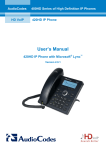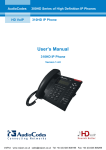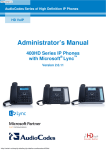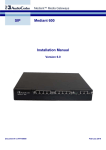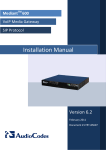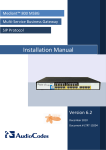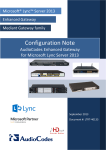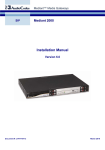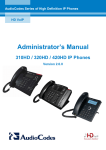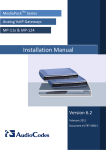Download User`s Manual
Transcript
AudioCodes HD VoIP 400HD Series of High Definition IP Phones 420HD IP Phone User’s Manual 420HD IP Phone Version 2.0.2 User's Manual Contents Table of Contents 1 2 Introducing the 420HD IP Phone ................................................................................ 9 1.1 About AudioCodes' Series of High Definition IP Phones ...................................................9 1.2 Complete Range of Phones ...............................................................................................9 1.3 Cutting Edge Voice Quality & HD VoIP .............................................................................9 Setting up the Phone................................................................................................. 11 2.1 Unpacking ........................................................................................................................11 2.2 Device Description ...........................................................................................................11 2.2.1 2.2.2 2.3 Cabling.............................................................................................................................14 2.4 Mounting the Phone .........................................................................................................15 2.4.1 2.4.2 3 4 Front View .......................................................................................................................... 11 Rear View .......................................................................................................................... 13 Desktop Mounting .............................................................................................................. 15 2.4.1.1 Routing the Handset Cable ................................................................................ 15 Wall Mounting .................................................................................................................... 16 Getting Started........................................................................................................... 17 3.1 LCD in Idle State..............................................................................................................17 3.2 Softkeys ...........................................................................................................................18 3.3 Accessing Menus .............................................................................................................19 3.4 Entering Numbers, Alphabetical Letters and Symbols ....................................................20 3.5 Displayed Messages........................................................................................................22 Customizing Your Phone .......................................................................................... 23 4.1 Changing the LCD Language ..........................................................................................23 4.2 Selecting Ring Tone ........................................................................................................24 4.3 Setting Date and Time .....................................................................................................25 4.4 Changing LCD Contrast Level .........................................................................................26 4.5 Defining the LCD Backlight Timeout ................................................................................27 4.6 Selecting Audio Device ....................................................................................................28 4.7 Adjusting Volume .............................................................................................................29 4.7.1 4.7.2 4.7.3 4.7.4 4.7.5 Adjusting Ring Volume ...................................................................................................... 29 Adjusting Tones Volume .................................................................................................... 29 Adjusting Handset Volume ................................................................................................ 29 Adjusting Speakerphone Volume ...................................................................................... 30 Adjusting Headset Volume ................................................................................................ 30 4.8 Enabling Call Waiting.......................................................................................................31 4.9 Defining Call Forwarding .................................................................................................32 4.10 Managing Your Personal Directory ..................................................................................33 4.10.1 4.10.2 4.10.3 4.10.4 4.10.5 Accessing the Directory ..................................................................................................... 33 Adding Contacts to the Personal Directory ........................................................................ 33 Editing Contact Information ............................................................................................... 34 Deleting a Contact ............................................................................................................. 35 Searching for a Contact ..................................................................................................... 35 4.11 Defining a Speed Dial Key ...............................................................................................36 4.11.1 Assigning a Phone Number to a Key ................................................................................. 36 Version 2.0.2 3 June 2013 420HD IP Phone 4.11.2 Editing a Speed Dial Assignment ...................................................................................... 37 4.11.3 Deleting Speed Dials ......................................................................................................... 37 5 Performing Basic Operations ................................................................................... 39 5.1 Using Audio Devices ........................................................................................................39 5.2 Making Calls ....................................................................................................................39 5.2.1 5.2.2 5.2.3 6 Dialing ................................................................................................................................ 40 Redialing ............................................................................................................................ 40 Dialing a Missed Call ......................................................................................................... 41 5.3 Answering Calls ...............................................................................................................41 5.4 Rejecting Incoming Calls .................................................................................................42 5.5 Silencing Incoming Calls ..................................................................................................42 5.6 Ending an Established Call ..............................................................................................43 5.7 Viewing Missed, Received and Dialed Calls ....................................................................44 Performing Advanced Operations ........................................................................... 47 6.1 Answering Waiting Calls ..................................................................................................47 6.2 Placing Calls On Hold ......................................................................................................48 6.3 Calling a Contact Listed in the Directory ..........................................................................48 6.4 Using a Speed Dial Key to Make a Call ...........................................................................49 6.5 Transferring Calls ............................................................................................................49 6.5.1 6.5.2 6.5.3 Attended Transfer .............................................................................................................. 49 Semi-Attended Transfer ..................................................................................................... 50 Blind Transfer..................................................................................................................... 50 6.6 Hosting 3‐Way Conference Calls .....................................................................................51 6.7 Muting Calls .....................................................................................................................51 6.8 Activating Do Not Disturb .................................................................................................51 6.9 Retrieving Voice Mail Messages ......................................................................................52 6.10 Using Two Lines ..............................................................................................................53 6.10.1 6.10.2 6.10.3 6.10.4 6.10.5 6.10.6 6.10.7 6.10.8 7 Choosing a Line ................................................................................................................. 53 Making a Call on a Line ..................................................................................................... 53 Making Two Calls on a Line ............................................................................................... 54 Making Multiple Line Calls ................................................................................................. 54 Toggling Between Multiple-Line Calls................................................................................ 54 Toggling Between Calls on the Same Line ........................................................................ 55 Answering Calls ................................................................................................................. 55 Ending Calls ....................................................................................................................... 55 Troubleshooting ........................................................................................................ 57 User's Manual 4 Document #: LTRT-11881 User's Manual Contents List of Figures Figure 2-1: Front View ...................................................................................................................................... 12 Figure 2-2: Rear View ....................................................................................................................................... 13 Figure 2-3: Cabling ........................................................................................................................................... 14 Figure 3-1: LCD in Idle State ............................................................................................................................ 17 Figure 3-2: Menus............................................................................................................................................. 19 Figure 3-3: Alphanumerical Selection............................................................................................................... 20 Figure 3-4: Selected Alphanumerical Mode (Abc) ............................................................................................ 20 Figure 3-5: Entering a Symbol such as a Full Stop .......................................................................................... 21 Version 2.0.2 5 June 2013 420HD IP Phone List of Tables Table 2-1: Font View Description ..................................................................................................................... 12 Table 2-2: Rear View Description ..................................................................................................................... 13 Table 3-1: LCD in Idle State ............................................................................................................................. 17 Table 3-2: Softkeys ........................................................................................................................................... 18 Table 3-3: Messages Displayed on LCD Indicating Processes In Progress .................................................... 22 Table 7-1: Troubleshooting ............................................................................................................................... 57 User's Manual 6 Document #: LTRT-11881 User's Manual Notices Notice This document shows how to use the AudioCodes 420HD IP Phone. Information contained in this document is believed to be accurate and reliable at the time of printing. However, due to ongoing product improvements and revisions, AudioCodes cannot guarantee accuracy of printed material after the Date Published nor can it accept responsibility for errors or omissions. Updates to this document and other documents can be viewed by registered customers at http://www.audiocodes.com/downloads. © Copyright 2013 AudioCodes Ltd. All rights reserved. This document is subject to change without notice. Date Published: June-27-2013 Trademarks AudioCodes, AC, AudioCoded, Ardito, CTI2, CTI², CTI Squared, HD VoIP, HD VoIP Sounds Better, InTouch, IPmedia, Mediant, MediaPack, NetCoder, Netrake, Nuera, Open Solutions Network, OSN, Stretto, TrunkPack, VMAS, VoicePacketizer, VoIPerfect, VoIPerfectHD, What’s Inside Matters, Your Gateway To VoIP and 3GX are trademarks or registered trademarks of AudioCodes Limited. All other products or trademarks are property of their respective owners. WEEE EU Directive Pursuant to the WEEE EU Directive, electronic and electrical waste must not be disposed of with unsorted waste. Please contact your local recycling authority for disposal of this product. Customer Support Customer technical support and service are generally provided by AudioCodes’ Distributors, Partners, and Resellers from whom the product was purchased. For technical support for products purchased directly from AudioCodes, or for customers subscribed to AudioCodes Customer Technical Support (ACTS), contact [email protected]. Abbreviations and Terminology Each abbreviation, unless widely used, is spelled out in full when first used. Documentation Feedback AudioCodes continually strives to produce high quality documentation. If you have any comments (suggestions or errors) regarding this document, please fill out the Documentation Feedback form on our Web site at http://www.audiocodes.com/downloads. Version 2.0.2 7 June 2013 420HD IP Phone Related Documentation Document Name 400HD IP Phone Release Notes 420HD, 430HD & 440HD IP Phone Administrator's Manual 420HD IP Phone Quick Guide User's Manual 8 Document #: LTRT-11881 1. Introducing the 420HD IP Phone User's Manual 1 Introducing the 420HD IP Phone AudioCodes’ 420HD IP Phone is based on AudioCodes’ High Definition voice technology, providing clarity and a rich audio experience in Voice-over-IP (VoIP) calls. The 420HD is a two-line, two concurrent calls per line premium model which includes a large monochrome multilanguage graphic LCD display. The 420HD IP Phone is a fully-featured telephone that provides voice communication over an IP network, allowing you to place and receive phone calls, put calls on hold, transfer calls, make conference calls, etc. Read this User’s Manual to learn how to operate this product and take advantage of its multiple features. 1.1 About AudioCodes' Series of High Definition IP Phones AudioCodes Series of High Definition IP Phones offers a new dimension of voice call quality and clarity for the IP Telephony market. This new series of IP Phones further expands AudioCodes’ VoIP product offering for the service providers’ hosted services, Enterprise IP telephony and Enterprise contact centers markets. As a natural addition to the AudioCodes Mobile Clients, Media Gateway, Media Server & Multi-Service Business Gateway products, the AudioCodes Series of High Definition IP Phones enable Systems Integrators and end-customers to build endto-end solutions that rely on AudioCodes’ technological advantage and proven track record in providing state-of-the-art products. The AudioCodes Series of High Definition IP Phones meet a growing demand for High Definition VoIP solutions in end-user phones and terminals, improving the productivity and efficiency of business communications with new quality standards set by the High Definition voice technology. 1.2 Complete Range of Phones AudioCodes’ 400HD Series of High Definition IP Phones are well suited to the requirements of different types of business users. The series currently includes the 420HD phone featuring two lines (two concurrent calls per line), a multi-lingual graphic LCD display (128 X 48), and four programmable softkeys; the 430HD phone featuring six lines (two concurrent calls per line), a graphic multi-lingual LCD display (132 X 64), six multi-function keys, 12 programmable speed dial keys, four programmable soft keys, and optional GbE support; and the 440HD phone featuring six lines (two concurrent calls per line), a graphic multi-lingual LCD display (132 X 64), six multi-function keys, 12 programmable speed dial keys and contacts displayed on a dedicated LCD screen (376 X 60), four programmable soft keys, and GbE support. All phone’s support HDVoIP. The phones are available with Power over Ethernet and/or external power supply. 1.3 Cutting Edge Voice Quality & HD VoIP Based on AudioCodes’ advanced, robust and field-proven VoIPerfectHD™ software, AudioCodes’ IP Phones are designed to utilize the most popular wideband coders such as G.722 and Microsoft® Real Time Audio (RTA). Each of these phones features enhanced proprietary capabilities, such as packet loss concealment, high quality wideband acoustic echo canceler, and low-delay adaptive jitter buffers to enrich the HDVoIP experience. Version 2.0.2 9 June 2013 420HD IP Phone Reader’s Notes User's Manual 10 Document #: LTRT-11881 2. Setting up the Phone User's Manual 2 Setting up the Phone 2.1 Unpacking When unpacking, ensure that the following items are present and undamaged: 420HD IP Phone / Stand Handset / Cord Cat 5e Ethernet Cable AC Power Adapter (Optional) If anything appears to be missing or broken, contact the distributor from whom you purchased the phone for assistance. 2.2 Device Description Use the graphics below to identify and familiarize yourself with the device's hardware functions. 2.2.1 Front View The front view of the phone is shown in Figure 2-1 and described in Table 2-1. Version 2.0.2 11 June 2013 420HD IP Phone Figure 2-1: Front View 1 2 3 4 5 15 6 7 14 8 13 9 12 10 11 Table 2-1: Font View Description Item # Label/Name Description 1 Ring LED Flashing blue light visually indicates an incoming call. 2 LCD Liquid Crystal Display - interactive screen displaying calling information, enabling you to set up phone features. 3 Softkeys See Section 3.2 on page 18 for details on the four softkeys and the available functions they offer. 4 Navigation Control / OK Press the upper rim to scroll up menus/items in the LCD display screen. Press its lower rim to scroll down. Press its left or right rim to move the cursor left or right (when editing a contact number for example). Press the OK button to select a menu/item/option. 5 VOICE MAIL Retrieves voice mail messages. 6 CONTACTS Press to directly access the Personal directory. User's Manual 12 Document #: LTRT-11881 2. Setting up the Phone User's Manual Item # Label/Name 7 MENU 8 9 10 11 REDIAL TRANSFER HOLD Alphanumerical Keypad SPEAKER HEADSET MUTE ▲ VOL VOL ▼ 12 13 14 15 2.2.2 Description Accesses menus (1) Call Log (2) Directory (3) Speed Dial (4) Settings (5) Status (6) Administration. Accesses a list of recently dialed numbers; one can be selected to redial. Transfers a call. Places an active call on hold. Keys for entering numbers, alphabetical letters and symbols (e.g., colons) Activates the speakerphone, allowing a hands-free conversation. Activates a call using an external headset. Mutes a call. Increases or decreases the volume of the handset, headset, speakerphone, ring tone and call progress tones. Rear View The rear view of the phone is shown in the figure below and described in the table below. Figure 2-2: Rear View 1 2 5 3 4 Table 2-2: Rear View Description # 1 2 3 4 5 Version 2.0.2 Label Description Handset jack, i.e., RJ-9 port, to connect the handset. RJ-45 port to connect to the Ethernet LAN cable for the LAN connection (uplink - 10/100 Mbps). If you're using Power over Ethernet (PoE), power to the phone is supplied from the Ethernet cable (draws power from either a spare line or signal line). RJ-45 port for connecting the phone to a PC (10/100 Mbps downlink). 12V DC power jack that connects to the AC power adapter. Headset jack, i.e., RJ-9 port that connects to an external headset. 13 June 2013 420HD IP Phone 2.3 Cabling This section shows how to cable your phone. Figure 2-3: Cabling 4 3 2 5 1 Action Description 1 Connect the short, straight end of the cord to the handset. Connect the longer, straight end to the jack (RJ-9 port, for the handset) on the phone. 2 Connect the RJ-45 LAN port to your LAN network (LAN port or LAN switch/router), using a CAT 5 / 5e Ethernet cable 3 Connect the RJ-45 PC port to a computer, using a CAT 5 / 5e straight-through Ethernet cable 4 5 Connect the connector tip of the AC power adapter to the phone’s power socket (labelled DC 12V). Connect the two-prong AC adapter directly to the electrical wall outlet. When the phone powers up, all the LEDs momentarily light up Connect the RJ-9 headset jack to a headset (optional) Note: If the LAN to which the phone is connected supports Power over Ethernet (PoE), no AC adapter is required; the phone receives power from the Ethernet network. Prior to connecting power, refer to the Compliancy and Regulatory Information at www.audiocodes.com/library. User's Manual 14 Document #: LTRT-11881 2. Setting up the Phone User's Manual 2.4 Mounting the Phone The phone can be mounted on a: 2.4.1 Desk (see Section 2.4.1 below) Wall (see Section 2.4.2 on page 16) Desktop Mounting This section shows how to place the phone on a desk or flat surface. To mount the phone on a desk or flat surface: 2.4.1.1 1. Off-hook the handset (if on-hook) and place the phone upside down, i.e., base-up, on your desktop. 2. On the phone's base, identify outer rails. 3. On the phone's stand, identify outer notches. 4. Invert the stand and align its outer notches with the base's outer rails. 5. Insert the stand's outer notches into the base's outer rails and slide the notches along the rails until the stand click-locks into the base. 6. Revert the phone and stand it on the desktop. Routing the Handset Cable The phone features a groove for routing the handset cable. Version 2.0.2 15 June 2013 420HD IP Phone 2.4.2 Wall Mounting This section shows you how to mount the phone on a wall or wall plate. To mount the phone on a wall: 1. Attach the stand of the phone for the purpose of a wall mounting: a. Detach the base. To detach the phone's stand, push this button b. Attach it again as you did for a desktop mounting (see Section 2.4.1 on page 15) only now make sure that it's flatly aligned to lie flush against the wall, i.e., slide the middle rails of the phone stand onto the phone base's inner notches. 2. Connect the AC power adapter, LAN and PC cords. 3. In the wall, drill two horizontal holes at a distance of 3 15/16 inches (100 mm) from one another, in line with the template. 4. Insert two masonry anchors into the holes if necessary. 5. Thread two screws (not supplied) into the two masonary anchors; ensure that the heads extend sufficiently (about 3/16 inch or 5 mm from the wall) for the phone stand's keyhole slots to hang on. 6. Hang the phone stand's keyhole slots on these screws. User's Manual 16 Document #: LTRT-11881 3. Getting Started User's Manual 3 Getting Started Your phone features an LCD, providing an intuitive, menu-driven user interface for configuring the phone and viewing call information. This section shows how to use the phone’s LCD. 3.1 LCD in Idle State The figure below shows the phone’s LCD in idle state. See the table below for reference. Figure 3-1: LCD in Idle State 3 1 4 2 Table 3-1: LCD in Idle State Reference Description 1 Extension lines (won't be displayed unless configured by system administrator) 2 Softkeys; to activate a softkey, press the key corresponding to it located below the LCD. 3 Time 4 Date Version 2.0.2 17 June 2013 420HD IP Phone 3.2 Softkeys The table below describes softkeys displayed in the LCD according to menu level currently accessed. To use a softkey, press the key located on the device directly below it. Table 3-2: Softkeys Softkey Description Missed Displays missed calls. Forward Defines and activates call forwarding. DnD Displayed in idle state. Activates the Do not Disturb feature. Displayed in idle state. Also displayed (for example) after lifting the handset and after selecting New Call, Conf or Trans (see below). Opens the phone's Directory (enables selecting a contact in the Corporate directory or Personal directory). Select Selects a menu or menu option. Identical to the OK key (either can be used). A/a/l Enables choosing letters or digits (1). The letters option can be all caps (ABC), all small letters (abc) or first letter capitalized (Abc). Save Saves settings. Cancel Cancels the currently initiated call or configuration. Dial Displayed after a number is keyed, a directory contact is selected, or a logged call is selected. Dials the phone number / directory contact / logged call. Clear Displayed for example after keying the first digit of a phone number. Deletes from right to left each time the digit or character is pressed. To delete all digits/characters, keep pressed until all are deleted. New Call Displayed after a number is dialed and the call is answered on the other side. Also shown after a call is answered. Enables keying a number or URL and calling them. Conf Displayed after a number is dialed and the call is answered on the other side. Also shown after a call is answered. Enables keying a number or URL to include in the current call. Transf. Displayed after a number is dialed and the call is answered on the other side. Also shown after a call is answered. Enables keying a number or URL to transfer the call to. URL Displayed after lifting the handset, after selecting New Call, Conf or Trans, and after keying the key. Enables calling a URL. Displayed after lifting the handset. Also displayed after New Call, Conf or Trans is selected. Presents menu items All Calls, Missed Calls, Received Calls, Dialed Calls. Call Log Detail Displayed (for example) after selecting a Call Log submenu: All Calls, Missed Calls, Received Calls or Dialed Calls. Displays the submenu's settings. End Displayed for example after pressing the Dial softkey and when the called party lifts the handset/accepts the call. Also displayed after accepting an incoming call or lifting the handset to answer. Ends the call. Back Displayed for example after pressing the MENU key as well as after selecting any of the submenu's under it. Returns you to the previous screen state or menu level. Start Displayed after pressing Forward > selecting an extension line > selecting when to forward. Activates call forwarding. Edit Displayed after a menu/submenu item to be edited is selected. Enables editing the selected item. Delete Displayed after pressing the MENU key > selecting Call Log softkey > selecting submenu All Calls, Missed Calls, Received Calls or Dialed Calls). Before deleting the submenu, a warning prompt is displayed. User's Manual 18 Document #: LTRT-11881 3. Getting Started User's Manual 3.3 Accessing Menus Menus are used to access information and to configure the phone. For example, Personal directory under Directory is used to add contacts; Missed Calls under Call Log is used to view missed calls and to reply to them; Network Status under Status is used to view the phone's dynamic IP address. The figure below shows the phone's menus and submenus. Figure 3-2: Menus Note: Version 2.0.2 The Administration menu is intended for system administrators only. It is password protected. For information regarding this menu, refer to the 420HD IP Phone Administrator’s Manual. If you define a second extension line, the Call Log menu displays menu items per extension. 19 June 2013 420HD IP Phone To access the menus: Press the MENU key located on the device. To navigate to menus and items: Press the navigating control's upper and lower rim -OR- press the listed item's number on the keypad, e.g., press 3 to navigate to Speed Dial. To select a menu or menu item: Press the Select softkey or press the navigation control's OK button. To cancel and move to a previous menu level: 3.4 Press the Back softkey. Entering Numbers, Alphabetical Letters and Symbols The phone’s alphanumerical keypad lets you to enter alphabetical letters, numbers and symbols. Press the A/a/1 softkey successively or the # pound key successively to navigate to and select alphabet mode, number mode or symbol mode. To define a contact name, you need alphabet mode. To define an IP address, you need to revert from number mode to symbol mode : and back to number, etc. If you press the keys on the keypad when the LCD is in idle state, the numbers printed on the keys are dialed for a new key. To enter a letter of the alphabet or a number (alphanumerical selection): 1. Successively press the A/a/1 softkey or # key to navigate to and select the mode required: Figure 3-3: Alphanumerical Selection 2. Choose either: abc = lower case letters ABC = upper-case letters Abc = first-letter upper case, the rest lower case 123 = numerical mode (i.e., numbers) After selecting, the LCD displays your selection. Figure 3-4: Selected Alphanumerical Mode (Abc) 3. User's Manual To enter a letter, press the required alphanumerical key on the keypad. Successive presses on the same key moves you to that key's next letter. Pressing another key enters the first letter indicated on it. 20 Document #: LTRT-11881 3. Getting Started User's Manual To enter a symbol such as a period (full stop): 1. Press the A/a/1 softkey successively to navigate to and choose ABC mode -OR- press the pound # key successively to navigate to and choose ABC mode or abc mode (see 1 below). 2. Press the 1 key on the keypad; a semi-colon is entered. Immediately press 1 again; a colon is entered. Immediately press 1 again; a period is entered. 3. To revert to numbers, for example, press the pound # key successively to navigate to and choose 123 mode (see 2 below). Figure 3-5: Entering a Symbol such as a Full Stop 1 2 Pressing the 1 key produces: ; (semi-colon) : (colon) . (period) @ (at) # $ (dollar) % (percentage) ^ (caret) & (ampersand) + (plus) - (minus) _ (underscore) (pound) Note that the asterisk (*) symbol is entered directly using the star key. Version 2.0.2 21 June 2013 420HD IP Phone 3.5 Displayed Messages Messages indicating processes in progress, displayed in the LCD, include: Table 3-3: Messages Displayed on LCD Indicating Processes In Progress Message Description Initializing Initializing Discovering LLDP Discovering Link Layer Discovery Protocol (LLDP) for initialization Discovering CDP Discovering Cisco Discovery Protocol (CDP) for initialization Acquiring IP Acquiring an IP address from a DHCP server Initializing Network Initializing the network Registering Registering to a SIP proxy server (at phone bootup) Registration in Progress SIP Registration in Progress Registration Failure SIP Registration failure Downloading Firmware File Downloading a firmware file Upgrading Firmware Upgrading the phone’s firmware Updating Configuration Loading a configuration file User's Manual 22 Document #: LTRT-11881 4. Customizing Your Phone User's Manual 4 Customizing Your Phone This section shows you how to customize your phone for enhanced usability. 4.1 Changing the LCD Language The LCD supports multiple languages. English is the default but you can change it to another. To change the default: 1. Access the Languages screen (MENU key > Settings > Language). 2. Navigate to the language you require. 3. Press the Select softkey to select it. 4. Press the Save softkey to save the setting. Version 2.0.2 23 June 2013 420HD IP Phone 4.2 Selecting Ring Tone The phone provides a selection of ring tones that you can choose from to indicate incoming calls. If line extensions are defined on your phone, you can assign a ring tone per line extension. To select a ring tone: 1. Access the Ring Tone screen (MENU key > Settings > Ring Tone). 2. In the Ring Tone screen select All Extensions to assign the ring tone to all extensions or select the required extension if the phone has extensions and then navigate to and select a ring tone. A sample of each ring tone is played as you navigate through the list. 3. Set ring tone volume by pressing VOL or VOL key: A few seconds after adjusting the volume level, the Ringer Volume indication is hidden. 4. Press the Select softkey to apply your settings. 5. Press the Save softkey to save your settings. User's Manual 24 Document #: LTRT-11881 4. Customizing Your Phone User's Manual 4.3 Setting Date and Time You can manually set date and time displayed on your phone. However, if a Network Time Protocol (NTP) server is deployed and enabled by your administrator, then date and time is automatically retrieved over the Internet from the server and manually setting date and time will not be possible. You'll receive this message: Notes: It's recommended to implement an NTP server which is configured by your system administrator (see the 420HD IP Phone Administrator’s Manual). If you're manually setting date and time, i.e., no NTP server is deployed, then after rebooting the phone or powering off, date and time settings are not retained. Thus, if you reboot the phone or power off, you need to redefine date and time. To define date and time: 1. Access the Date and Time screen (MENU key > Settings > Date and Time). 2. Select the Date option and modify using the Clear softkey. The date format is DDMMYYYY. 3. Navigate down to and select the Time option. The time is in the format hhmmss. Modify using the Clear softkey. 4. Navigate down to and select the Time format option. 5. Press the navigation control's left rim to change the format from 24h to 12h if required. 6. Press the Select soft key to choose a format. 7. Press the Save softkey to save your settings. Version 2.0.2 25 June 2013 420HD IP Phone 4.4 Changing LCD Contrast Level The LCD supports 35 different contrast levels. To define the LCD’s contrast level: 1. Access the LCD Contrast submenu (MENU key > Settings > LCD Contrast). 2. Press the navigation control's left or right rim to navigate to the contrast level that suits you best (0 to 35). 3. Press the Save softkey to apply your settings. User's Manual 26 Document #: LTRT-11881 4. Customizing Your Phone User's Manual 4.5 Defining the LCD Backlight Timeout You can define the duration, in seconds, for which the phone’s backlight is lit when the phone is not being used (idle). After this duration expires, the backlight turns off. You can also opt to have the backlight on all the time by selecting the Always on option. To define the LCD’s backlight timeout: 1. Access the Backlight Timeout screen (MENU key > Settings > Backlight Timeout). 2. Navigate to and select Always on or 10 seconds (default) 20 seconds, 30 seconds, 40 seconds, 50 seconds or 60 seconds). 3. Press the Select softkey to apply your settings. 4. Press the Save softkey to save your settings. Version 2.0.2 27 June 2013 420HD IP Phone 4.6 Selecting Audio Device You can select which audio device - speaker or headset - is activated when you answer calls (by pressing the Accept softkey or lifting the handset) or when you dial calls (by pressing the number keys on the keypad and then pressing the Dial softkey). The speaker is the default audio device. To select the audio device: 1. Access the Answer Device screen (MENU key > Settings > Answer Device). 2. Navigate to and select the audio device (Speaker or Headset) and press the Select softkey. 3. Press the Save softkey. User's Manual 28 Document #: LTRT-11881 4. Customizing Your Phone User's Manual 4.7 Adjusting Volume You can adjust the volume of the phone's: 4.7.1 Ring Tones (e.g., dial tone) Handset Speakerphone Headset Adjusting Ring Volume You can adjust the volume of the ring indicating an incoming call. To adjust ring volume: 4.7.2 1. When the phone is in idle state (i.e., not in use), press the VOL Ringer Volume bar is displayed on the screen: or VOL key; the 2. Press the VOL or VOL key on the keypad to adjust the volume. After adjusting, the Ringer Volume level disappears from the screen. Adjusting Tones Volume You can adjust the phone tones, including dial tone, ring-back tone and all other call progress tones. To adjust tones volume: 4.7.3 1. Off-hook the phone (using handset, speaker or headset). 2. Press the VOL 3. Press the VOL or VOL key to adjust the volume. After adjusting, the Tones Volume bar disappears from the screen. or VOL keyboard key; the Tones Volume bar displays on the screen: Adjusting Handset Volume The volume of the handset can be adjusted during a call or when making a call. After changing the volume, the newly adjusted level applies to all subsequent handset use. To adjust handset volume: 1. Version 2.0.2 During a call or when making a call ensure that the handset is off the cradle. 29 June 2013 420HD IP Phone 4.7.4 2. Press the VOL or VOL 3. Press the VOL or VOL disappears from the screen. key; the Handset Volume bar is displayed on the screen. key on the keyboard. After adjusting, the Handset Volume bar Adjusting Speakerphone Volume The volume of the speakerphone can only be adjusted during a call. After changing the volume, it applies to all subsequent speakerphone use. To adjust the speakerphone volume: 4.7.5 1. During a call, press the SPEAKER key. 2. Press the VOL 3. Adjust the volume using the VOL or VOL key. After you have completed adjusting the volume, the Speaker Volume bar disappears from the screen. or VOL key; the Speaker Volume bar is displayed on the screen. Adjusting Headset Volume The volume of the headset can only be adjusted during a call. Once you have changed the volume level, the volume applies to all subsequent headset use. To adjust the headset volume: 1. During a call, press the HEADSET key. 2. Press the VOL 3. Adjust the volume using the VOL or VOL Volume bar disappears from the screen. User's Manual or VOL key; the Headset Volume bar is displayed on the screen. 30 key. After adjusting the volume, the Headset Document #: LTRT-11881 4. Customizing Your Phone User's Manual 4.8 Enabling Call Waiting You can enable or disable the call waiting feature. To enable or disable call waiting: 1. Access the Call Waiting screen (MENU key > Settings > Call Waiting). 2. Navigate to and select: Disable (disables call waiting) -OR- Enable (enables call waiting) 3. Press the Select softkey to apply your settings. 4. Press the Save softkey to save your settings. Version 2.0.2 31 June 2013 420HD IP Phone 4.9 Defining Call Forwarding This feature enables you to automatically redirect an incoming call to another phone number if a user-defined condition is met, e.g., if the line is busy. You can also define a call forwarding rule per extension or for all extensions - if you've defined extensions. To define call forwarding: 1. Press the Forward softkey when the LCD is in idle state: 2. In the Forward screen, navigate to a specific line or to All Extensions and press the Select softkey: 3. In the Automatic Forward screen, navigate to a forwarding condition: 4. 5. No Reply: The call is forwarded if the incoming call is not answered after a user-defined time in seconds. To select the time, press the navigation control's left or right rim. Always: The call is always forwarded. Busy: The call is forwarded when the line is busy. Press the Select softkey and define the destination to where you want the call forwarded: Number To Forward: enter the number to which to forward the call. Select from Directory: press the navigation control's lower rim to navigate to and select this option and then select an existing contact to whom to forward the call. Press the Start softkey to activate call forwarding; an → icon appears adjacent to the extension/s on the idle screen indicating that call forwarding is active: To deactivate call forwarding: User's Manual When the phone is in on-hook state, press the Forward softkey; the → icon disappears from the extension/s on the screen. 32 Document #: LTRT-11881 4. Customizing Your Phone User's Manual 4.10 Managing Your Personal Directory You can add contacts to the Personal Directory and edit and delete them if necessary. After adding a contact, you can call the contact directly from the directory (see Section 6.3 on page 48). If you receive an incoming call from a contact listed in the directory, the LCD displays the name listed. If you assign a speed dial key to the contact, you can press it to call them. Note: You can add a maximum of 1,000 contacts to your Personal Directory. Your phone also features a Corporate Directory, set up by your system administrator by loading a file or using the LDAP (Lightweight Directory Access Protocol) server (see the 420HD IP Phone Administrator’s Manual). Corporate Directory contacts in your phone cannot be edited or deleted. 4.10.1 Accessing the Directory Accessing the directory is necessary to perform the management operations subsequently described. To access: 1. Press the CONTACTS key -or- when the LCD is in idle state press the softkey -or- press the MENU key and select Directory. Press the navigation control's lower rim to navigate to Personal directory. 2. Press the Select softkey to add a contact to the directory, edit or modify contact information, delete a contact, or search for a contact: 4.10.2 Adding Contacts to the Personal Directory This section shows how to add a contact to the Personal Directory. You can enter the contact's home number, office number and/or mobile number. You can also assign a speed dial key to a contact (you can assign keys 1 to 9 to up to 9 contacts). Version 2.0.2 33 June 2013 420HD IP Phone To add a contact to the phone directory: 1. Access the Personal directory. 2. Select 3. In the Modify contact screen, key in the ‘Name’ of the new contact (see Section 3.4 on page 20 for detailed instructions). 4. Navigate down and key in the new contact's ‘Office’ number (see Section 3.4 on page 20 for detailed instructions). Optionally, navigate down and key in the new contact's ‘Home’ and ‘Mobile’ numbers as well. 5. Press the Sp. Dial softkey to assign a speed dial key if required and navigate to the first Empty speed dial: 6. Press the Select softkey, a speed dial key is assigned to the contact. 7. Press the Save softkey; 'Contact Saved' is displayed. 8. To view the assigned speed dial, navigate down to the contact's name and press 'Detail'; navigate down to this screen: New contact (press the Select softkey): 4.10.3 Editing Contact Information This section shows how to edit contact information. To edit: 1. Access the Personal directory and navigate to the name of the contact to edit: 2. Press the Detail softkey: 3. Press the Edit softkey: User's Manual 34 Document #: LTRT-11881 4. Customizing Your Phone User's Manual 4. Modify the contact’s details and press the Save softkey. Note: Corporate directory contacts cannot be modified. 4.10.4 Deleting a Contact This section shows how to delete a contact from the directory. To delete a contact: 1. Access the Personal directory and navigate to the contact to delete: 2. Press the Detail softkey; the contact details are shown. 3. Press the Delete softkey; a 'Delete current contact?' warning message appears: 4. Press the Yes softkey to remove the contact from the phone directory or No if you want to keep the contact in the directory; the contact is removed from the directory. Note: Corporate directory contacts cannot be deleted. 4.10.5 Searching for a Contact The search feature enables you to quickly and easily locate a contact in the directory. The feature is especially useful if you have a long list of contacts. To search for a contact: 1. Access the phone directory. 2. Search for a contact: Navigate to the contact in the list -OR- Version 2.0.2 Key the first letter in the contact's name using the keypad. As you press the key, the directory locates contacts whose names begin with that letter. For example, to search for the contact John, as you press he 'j' key the directory locates contacts whose names begin with "j". As you key in the next letter, i.e., 'o', contacts whose names begin with 'jo' appear, etc. 35 June 2013 420HD IP Phone 4.11 Defining a Speed Dial Key This section shows how you can set up quickly calling someone by pressing a (speed dial) key to which you assigned their phone number. You can assign a maximum of 9 phone numbers to 9 keys. In addition to assigning a phone number to a key, you can assign a directory contact. 4.11.1 Assigning a Phone Number to a Key This section shows how to assign a phone number to a (speed dial) key. The section shows how a speed dial key is typically defined, i.e., MENU key > Speed Dial. Note: Two alternative ways to assign a speed dial key are: 1. Press protractedly on an as yet unassigned keypad key > the Speed Dial # screen opens 2. Access the phone directory > 'Modify contact' screen > Sp. Dial softkey To assign a phone number to a key: 1. Access the Speed Dial screen (MENU key > Speed Dial). 2. Navigate to an Empty speed dial key (unassigned) and press the Select softkey; the selected speed dial key, #6 in the example below, is displayed: Notes: 3. Assign a phone number to the key: Define the phone number: a. In the ‘Type Number’ field, enter the phone number that you want to assign to the speed dial key: b. Press the Save softkey to save your settings. -OR- assign a contact from the phone directory: a. User's Manual Speed Dial #1 = topmost speed dial key on your phone Speed Dial #9 = lowermost speed dial key on your phone Navigate down to ‘Select from directory’ 36 Document #: LTRT-11881 4. Customizing Your Phone User's Manual b. Press the Select softkey; the ‘Personal directory’ menu item in the Directory screen is displayed: c. Press the Select softkey; the phone directory is displayed listing all contacts: d. Navigate to the contact to assign to the key and press the Select softkey to select the number. e. Press the Save softkey to save your settings. 4.11.2 Editing a Speed Dial Assignment You can edit a speed dial assignment. To edit: 1. Access the Speed Dial screen (MENU key > Speed Dial). 2. Navigate down to the speed dial key to edit and press the Select softkey. 3. Modify the fields as required. 4. Press the Save softkey to save your settings. 4.11.3 Deleting Speed Dials You can delete a speed dial assignment. To delete a speed dial: 1. Access the Speed Dial screen (MENU key > Speed Dial). 2. Navigate to the speed dial assignment that you want to delete and press the Select softkey. 3. In the ‘Type Number’ field, delete the entire number, using the Clear softkey. 4. Press the Save softkey; the Speed Dial is listed as 'Empty'. Version 2.0.2 37 June 2013 420HD IP Phone Reader’s Notes User's Manual 38 Document #: LTRT-11881 5. Performing Basic Operations User's Manual 5 Performing Basic Operations This section shows basic phone operations. 5.1 Using Audio Devices You can use one of the following audio devices on the phone for speaking and listening: Handset: To make a call or answer a call, lift the handset off the cradle. Speaker (hands-free mode). To activate it, press the speaker key during a call or when making a call. To deactivate it, press the speaker key again. Headset (hands-free mode). When talking on the phone, you can relay audio to a connected headset. To enable it, press the headset key. To disable it, press it again. You can easily change audio device during a call. 5.2 To change from speaker/headset to handset: Activate speaker/headset and pick up the handset; the speaker/headset is automatically disabled. To change from handset to speaker/headset: Off-hook the handset and press the speaker/headset key to activate the speaker/headset. Return the handset to the cradle; the speaker/headset remains activated. Making Calls The phone offers multiple ways of making a call. After dialing a number: and the called party’s phone number or contact name if it's listed in the LCD displays phone directory LCD displays the line extension number on which the called party is dialed The phone plays a ring-back tone LCD indications: To end dialing a call before it's answered: Press the End softkey or the speaker key. Note: For advanced dialing using the phone directory, see Section 4.10 on page 33. For defining a speed dial key, see Section 4.11 on page 36. For using multiple lines, see Section 6.10 on page 52. Version 2.0.2 39 June 2013 420HD IP Phone 5.2.1 Dialing This section shows how to dial. To dial, either (1) key-in the number on the keypad (2) press the speaker key and enter the number (3) press the speaker key or lift the handset and enter a URL address (e.g., host and domain name, or IP address) or alphabetical letters (e.g., tvservice). To dial a regular-digits phone number: 5.2.2 1. On the keypad, key the first digit of a regular phone number; the LCD displays the digit in the NEW CALL field; key in the remaining digits. To delete (from right to left) entered digits, press the Clear softkey. To cancel the call, press the Cancel softkey. 2. Press the Dial softkey (if you don't, dialling is automatically performed after a few seconds) or press the # (pound) key. To dial a URL: 1. Press the speaker key or lift the handset; the LCD displays the NEW CALL field and the URL softkey: 2. Press the URL softkey and enter a URL address, pressing the # key to toggle alphabetical letters and numerals (see Section 3.4 on page 20). To delete (from right to left) entered letters/numerals, press the Clear softkey. To cancel the call, press the Cancel softkey. 3. Press the Dial softkey. Redialing You can redial a number previously dialled. To redial: 1. Press the REDIAL key; the Dialed Calls screen is displayed, listing in chronological order, recently dialed numbers: 2. Navigate to and select the number to redial. 3. Press the Dial softkey or press the OK key on the phone’s keypad. User's Manual 40 Document #: LTRT-11881 5. Performing Basic Operations User's Manual 5.2.3 Dialing a Missed Call The phone logs all missed calls. The LCD in idle state displays the number of missed calls (if any): To dial a missed call: 5.3 1. Press the Missed softkey; the Missed Calls screen is displayed. 2. Navigate to the missed call to dial. 3. Press the Dial softkey or press the OK key on the phone’s keypad. Answering Calls The phone indicates an incoming call as follows: LCD displays together with the caller’s phone number (or contact name if listed in the phone directory): Phone rings. Ring LED flashes blue. To answer: Pick up the handset -or- Press the headset key (ensure that the headset is connected to the phone) -or- press the speaker key -or- press the Accept softkey -or- lift the handset: Note: HD in the LCD indicates a high-definition call (using a wideband voice coder). Version 2.0.2 41 June 2013 420HD IP Phone 5.4 Rejecting Incoming Calls You can reject an incoming call; the caller hears a busy tone from your phone if you do. To reject an incoming call: 5.5 Press the Reject softkey. Silencing Incoming Calls You can silence an incoming call's ringing. When you do, the caller hears normal ringing but no answer. To silence the ringing of an incoming call: Press the Silence softkey. Answer a silenced call by pressing the Accept softkey or picking up the handset. User's Manual 42 Document #: LTRT-11881 5. Performing Basic Operations User's Manual 5.6 Ending an Established Call You can end an established call. To end an established call: Return the handset to the phone cradle if it was used to take the call -or- Press the headset key -or- Press the speaker key -or- Press the End softkey Version 2.0.2 43 June 2013 420HD IP Phone 5.7 Viewing Missed, Received and Dialed Calls Your phone logs missed, received and dialed calls. In idle state, the LCD displays 'Missed' and the number of missed calls (if any). To view missed calls: Press the Missed softkey. Note: After viewing, the indication disappears from the screen. The next time a call is missed, the indication will reappear. To view call history: 1. Access the Call Log screen (MENU key > Call Log). 2. In the Call Log screen, navigate to and select with the Select softkey a specific extension or All Extensions; this screen opens. All Calls = calls that were missed, received and dialed Missed Calls = calls that were not answered Received Calls = the most recently answered numbers Dialed Calls = the most recently dialed numbers 3. Navigate to the option you want and press the Select softkey; a list of the logged calls is displayed, for example, Missed Calls: 4. Press the softkey you need: Dial = dials the number of the selected logged entry. Save = saves the related information about the call entry in the personal directory (for adding a contact in the directory, see Section 4.10 on page 33). Detail = accesses the Call Details screen, which displays details of the call entry: User's Manual 44 Document #: LTRT-11881 5. Performing Basic Operations User's Manual The Call Details screen displays the following logged call information: Number = phone number logged Time = the time the call was logged Date = the date on which the call was logged Duration = the duration of the call Notes: Version 2.0.2 The call history lists are stored from the newest to oldest entries. The maximum number of entries for each call history type is 200. Once this maximum is attained, the oldest entry is deleted and replaced with the new entry. The call history lists are saved on a daily basis. In the case of a power outage, some of the received information may be lost. If you view missed calls by pressing the Missed softkey, the missed calls notification no longer appears on the screen and reappears the next missed call. 45 June 2013 420HD IP Phone Reader's Notes User's Manual 46 Document #: LTRT-11881 6. Performing Advanced Operations User's Manual 6 Performing Advanced Operations This section shows how to perform advanced operations. 6.1 Answering Waiting Calls You can accept a call on an extension on which there already is an active call. This section shows how to answer a waiting call: a. A call with A is in progress on LINE 1 = call in progress b. A call comes in from B = call waiting To answer B: 1. Press the Accept softkey; the icon is displayed indicating that the waiting call from B is answered; the previous call from A is put on hold: 2. To toggle between the calls, press the navigation control's upper or lower rim. Note: To enable / disable the call waiting feature, see Section 4.8 on page 31. Version 2.0.2 47 June 2013 420HD IP Phone 6.2 Placing Calls On Hold You can place a call on hold, to answer a second incoming call (see Section 6.1 on page 47) or to make another call. To place a call on hold: Press the HOLD key; the call is put on hold: To retrieve a call on hold: 6.3 Press the HOLD key again -OR- press the Resume softkey. Calling a Contact Listed in the Directory This section shows how to call a contact listed in your directory. To call: 1. Press the CONTACTS key and then the Select softkey to access the directory. 2. Navigate to the contact to call (see also Section 4.10.5 on page 35). 3. Press the Dial softkey or the OK key. User's Manual 48 Document #: LTRT-11881 6. Performing Advanced Operations User's Manual 6.4 Using a Speed Dial Key to Make a Call A speed dial key can be used to quickly dial a phone number assigned to it. To assign a phone number to a speed dial key, see Section 4.11 on page 36. To use a speed dial key: Press a speed dial key (1-9) to which a phone number was assigned ; the phone automatically dials and calls the number. Note: If you press key 8, for example, and a phone number wasn't assigned to it, the LCD displays a Speed Dial #8 screen enabling you to assign. 6.5 Transferring Calls You can transfer a call to another party by pressing the Trans softkey. You can perform an attended transfer, a semi-attended transfer and a blind transfer. Transfer Method When Attended Transfer [also known as 'Consultative Transfer' and 'Supervised Transfer'] During an established call with Phone 2 you determine that they need to talk to Phone 3, so you press the Trans softkey and establish a call with Phone 3; the call with Phone 2 is put on hold. When Phone 3 answers, you ask if they can take a call from Phone 2. After they confirm, you press the Trans softkey again; the call with Phone 2 is transferred to Phone 3. Semi-Attended Transfer Same as Attended Transfer except that you transfer Phone 2 to Phone 3 while Phone 3 is ringing, before they answer. Blind Transfer During an established call with Phone 2 you're alerted to an incoming call from Phone 3. You answer Phone 3 who requests to be transferred to Phone 4. You press Trans to transfer Phone 3 to Phone 4 and you resume your original call with Phone 2. Note that your phone supports Blind Transfer only when one line is configured on it, not when two lines are configured. 6.5.1 Attended Transfer This section shows how to perform an attended transfer. To perform an attended transfer: 1. If during an established call with A she asks you to transfer her to M, press the Trans softkey; the New Call screen is displayed. 2. Enter M's number or press the Personal directory softkey to select M, and then press the now-enabled Dial softkey; M’s phone rings. 3. Press the Trans softkey only after M answers, after receiving his consent to take the call; A is transferred to M. This is an attended transfer. Version 2.0.2 49 June 2013 420HD IP Phone 6.5.2 Semi-Attended Transfer This section shows how to perform a semi-attended transfer. To perform a semi-attended transfer: 1. If during an established call with A she asks you to transfer her to M, press the Trans softkey; the New Call screen is displayed: 2. Enter M's number or press the Personal directory softkey to select M, and then press the Dial softkey; M's phone rings: 3. Press the Trans softkey before M answers without hearing if he answers; A is transferred to M. This is a semi-attended transfer. 6.5.3 Blind Transfer This section shows how to perform a blind transfer. To perform a blind transfer: 1. If during an established call with J an incoming call from A is indicated, accept it; J is automatically put on hold. 2. A requests to be transferred to M. Press the Trans softkey; the TRANSFER TO…screen is displayed. 3. Enter M's number or press the Personal directory softkey to select M. 4. Press the now-displayed Trans softkey; M’s phone rings and A is transferred. 5. Press the Resume softkey; resume your original call with John. User's Manual 50 Document #: LTRT-11881 6. Performing Advanced Operations User's Manual 6.6 Hosting 3‐Way Conference Calls This section shows how to make a 3-way conference call with two other parties. To make a 3‐way conference call: 1. Call the first participant (M); the call is established: 2. Press the Conf softkey; the CONFERENCE WITH…screen is displayed. 3. Enter the number of a second participant, A, and press the Dial softkey. When A answers, a call is established. 6.7 4. Press the Conf softkey again; a 3-way conference call is established and the names of all participants are displayed on the screen. 5. To end the conference call, hang up the phone or press the End softkey. Muting Calls You can mute the microphone of the handset, headset, or speakerphone during a call so that the other party cannot hear you. While the call is muted you can still hear the other party. Muting calls can also be used during conference calls. To mute/unmute: 6.8 1. During a call, press the MUTE key. 2. To unmute, press the MUTE key again and resume the conversation. Activating Do Not Disturb The Do Not Disturb (DnD) feature enables you to stop the phone from ringing when others call you. If DnD is activated when someone calls you: The caller hears a tone indicating that your phone is busy. The call is blocked and the idle screen indicates 'Missed Calls'. To activate: 1. Ensure that your phone is in idle state and that the idle screen is displayed, i.e., that you're not in an active call or dialing a number. 2. Press the DnD softkey and select All Extensions or a specific line on which to activate DnD, and press the Select softkey; the screen displays an icon Ө adjacent to the extension line/s indicating that incoming calls on them are blocked: To deactivate: 1. Version 2.0.2 Ensure that the phone is in idle state and that the idle screen is displayed, i.e., that you're not in an active call or dialing a number. 51 June 2013 420HD IP Phone 2. 6.9 Press the DnD softkey and select All Extensions or the specific line to deactivate, and press the Select softkey; the Ө icon is no longer displayed on the screen and your phone now rings for incoming calls. Retrieving Voice Mail Messages When you have at least one new message in your voice mail box, you can listen to it. To listen to voice mail messages: 1. Press the VOICE MAIL key: 2. Enter the number the VOICEMAIL box phone number; the phone dials your VOICEMAIL box. Follow the instructions of your voice mail provider. Note: If the VOICEMAIL box phone number has not been configured by your system administrator, then after pressing the VOICEMAIL key, enter the voice mail box phone number and then press the Save softkey. Press the VOICEMAIL key again to listen to voice messages. User's Manual 52 Document #: LTRT-11881 6. Performing Advanced Operations User's Manual 6.10 Using Two Lines Your phone supports up to two lines. Each is configured with its own extension number. The figure below displays the idle screen of a phone set up with two lines whose extension numbers are 1006 and 1005. Note: Only your phone/network administrator can configure the two lines. See the 420HD IP Phone Administrator’s Manual for detailed information. 6.10.1 Choosing a Line You can select a line to use. The screen displays a bar above the extension number of the line currently being used (see 1005 in the figure above). Until you change this line, all new calls are made on it and all new incoming calls are received on it. To change lines: 3. Ensure that the LCD is in idle state and that no calls are established. View the two configured lines displayed in the screen. View the bar above the currently used line. 4. Navigate to and select the other line; the bar moves above it; all new calls will now be made on it and all new incoming calls will be received on it. 6.10.2 Making a Call on a Line This section shows how to make a call on a line. To make a call on a line: 1. When the screen is in idle state, raise the handset or press the key of the first digit of the number to call; the NEW CALL screen is displayed: 2. Enter the number of the person to call or press the softkey to select a contact from the Directory and press the Dial softkey; the dialed number is called and the line on which the call is made is indicated in the screen. When the called party answers, this screen appears: Version 2.0.2 53 June 2013 420HD IP Phone 6.10.3 Making Two Calls on a Line Up to two calls per line can be made. This section shows how to make two calls on a line. To make two calls on a line: 1. Make a call on a line, for example, call M. After establishing this call, press the New Call softkey; the call with M is automatically put on hold and the NEW CALL screen is displayed. 2. Enter the phone number of a second party (A) or press the the directory and press the Dial softkey. softkey to select their entry in A answers. 3. To toggle between M (on hold) and A, press the navigation control's upper and lower rim (see Section 6.10.6 on page 55). 6.10.4 Making Multiple Line Calls Your phone supports multiple line calls. Two extension lines, defined by your administrator, are supported. Two calls can run simultaneously on each extension line. You can therefore have up to four calls running on your phone simultaneously, where one is active and three are on hold. This section shows how to make multiple line calls. Example scenario: 1. Extension line 1000 calls M 2. Extension line 2000 calls A To make a multiple line call: 1. When the screen is in idle state, navigate to and select the required line, e.g., 1000. 2. Lift the handset; the NEW CALL screen appears. 3. In the NEW CALL screen, enter the phone number or press the contact from your directory, e.g., M, whose number is 3000. 4. Press the Dial softkey. softkey to select a M answers. 5. Press the New Call softkey; the currently active call with M is automatically put on hold and you're prompted to enter a phone number or select a contact. 6. Before doing this, press the navigation control's left or right rim to navigate to line 2000. 7. Make another call exactly like you made the first call to M (on hold) but on line 2000: Enter a phone number or select a contact, e.g., A, and press the Dial softkey; A answers. 8. To toggle between M (on hold on line 1000) and A (active on line 2000), press the navigation control's upper and lower rim (see below). 6.10.5 Toggling Between Multiple-Line Calls After making calls on two different lines, you can toggle between them. When using two lines, one line is active while the other is on hold. Toggling between lines therefore involves putting the currently active call on hold and resuming the previously held call. The icon indicates an active line. The ײicon indicates a call that has been put on hold. User's Manual 54 Document #: LTRT-11881 6. Performing Advanced Operations User's Manual To toggle between multiple-line calls: Press the navigation control's upper or lower rim to select the conversation to resume and press the Resume softkey. 6.10.6 Toggling Between Calls on the Same Line This section shows how to toggle between two calls on the same line. How you do it depends on whether the first-placed call is active or the second-placed call is active. To switch from the first-placed call to the second-placed call: Press the navigation control's upper or lower rim to select the second-placed call and then press the Resume softkey; the first-placed call is automatically put on hold. To switch from the second-placed call to the first-placed call: Press the navigation control's upper or lower rim to select the first-placed call and then press the Resume softkey; the second-placed call is automatically put on hold. 6.10.7 Answering Calls The screen indicates an incoming call on a specific line (line extension number 1000 in the example below). To answer: View the oncoming call indication on the screen. Press the Accept softkey or lift the handset; the call is answered and all other calls are put on hold. 6.10.8 Ending Calls You can only end calls that are active, i.e., not on hold. To end a call: 1. Ensure that the call is active and not on hold. 2. Press the End softkey or the SPEAKER key. Version 2.0.2 55 June 2013 420HD IP Phone Reader’s Notes User's Manual 56 Document #: LTRT-11881 7. Troubleshooting User's Manual 7 Troubleshooting Use this section if a problem with your phone occurs. If this section does not facilitate resolving the issue, contact your system administrator. Table 7-1: Troubleshooting Symptom Problem Phone is off (no LCD displays and LEDs) Phone is not receiving power 'LAN Link Failure' message displayed on the LCD No LAN connection Corrective Procedure Verify that the AC/DC power adapter is attached firmly to the DC input on the rear of the phone. Verify that the AC/DC power adapter is plugged into the electrical outlet. Verify that the electrical outlet is functional. If using Power over Ethernet (PoE), contact your system administrator to check that the switch is supplying power to the phone. Verify that the LAN cable is connected securely to the LAN port on the rear of the phone. Verify that the other end of the LAN cable is connected to the network (switch). If it's not, inform your system administrator. Phone is not ringing Ring volume is set Increase the volume (see Section 4.7.1) too low 'Registration…' Line not registered message displayed to network on the LCD and calls cannot be made or received If your phone has multiple lines and an 'X' is displayed on the LCD for a line, this indicates that the line has not been successfully registered. For assistance, contact your system administrator. LCD display is poor Adjust the phone’s screen contrast level (see Section 4.4) Adjust the screen’s backlight timeout (see Section 4.5) Verify that your headset is securely plugged into the headset port located on the side of the phone. Verify that the headset volume level is adjusted adequately (see Section 4.7.5). Headset has no audio Version 2.0.2 LCD settings Headset not connected properly 57 June 2013 AudioCodes HD VoIP 400HD Series of High Definition IP Phones 420HD IP Phone User’s Manual 420HD IP Phone Version 2.0.2 www.audiocodes.com


























































